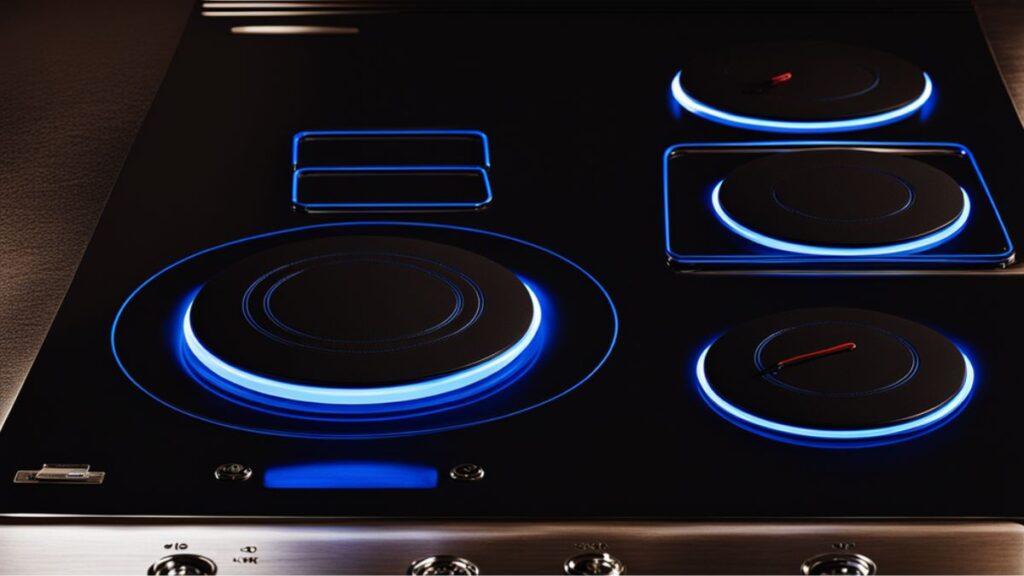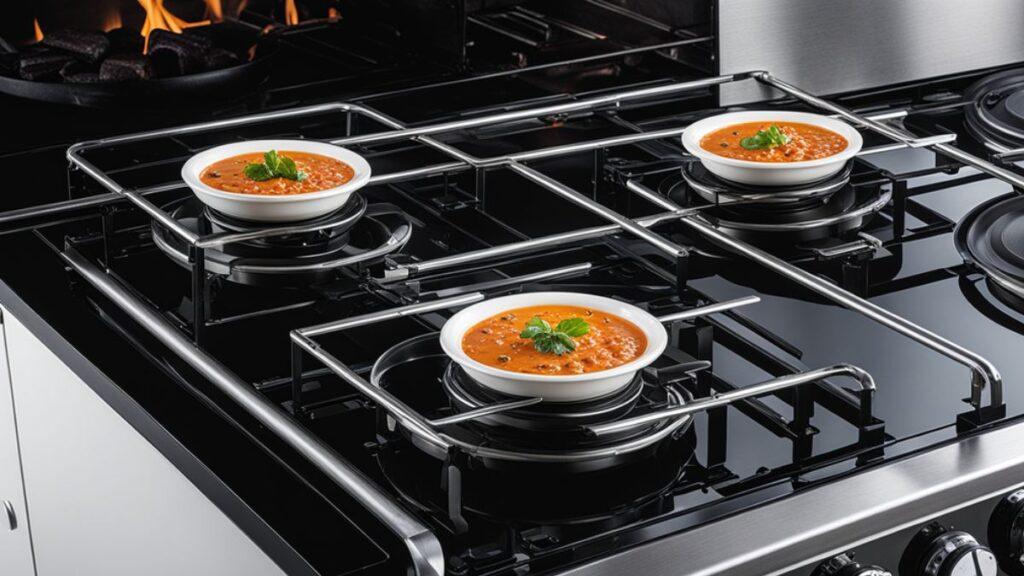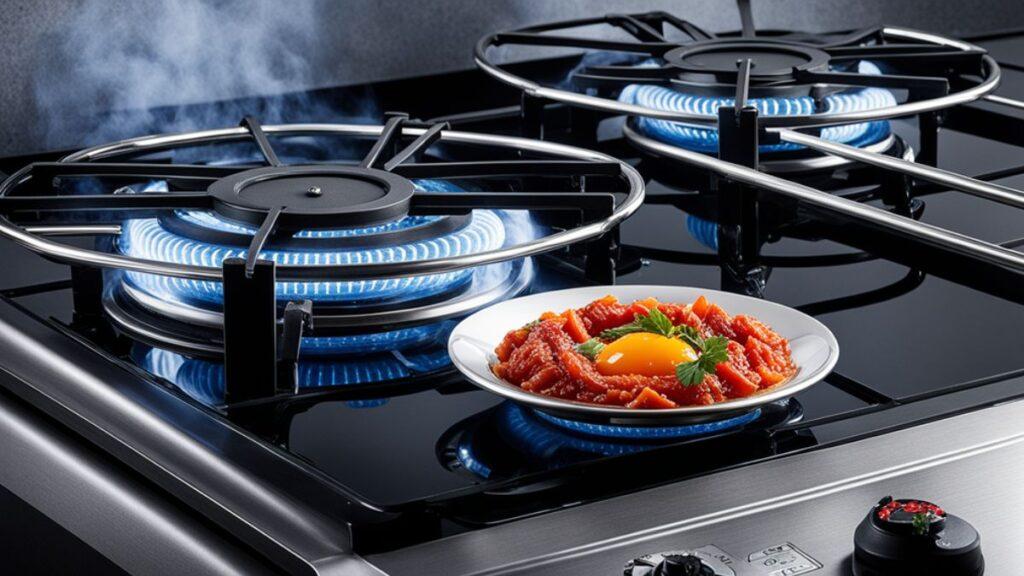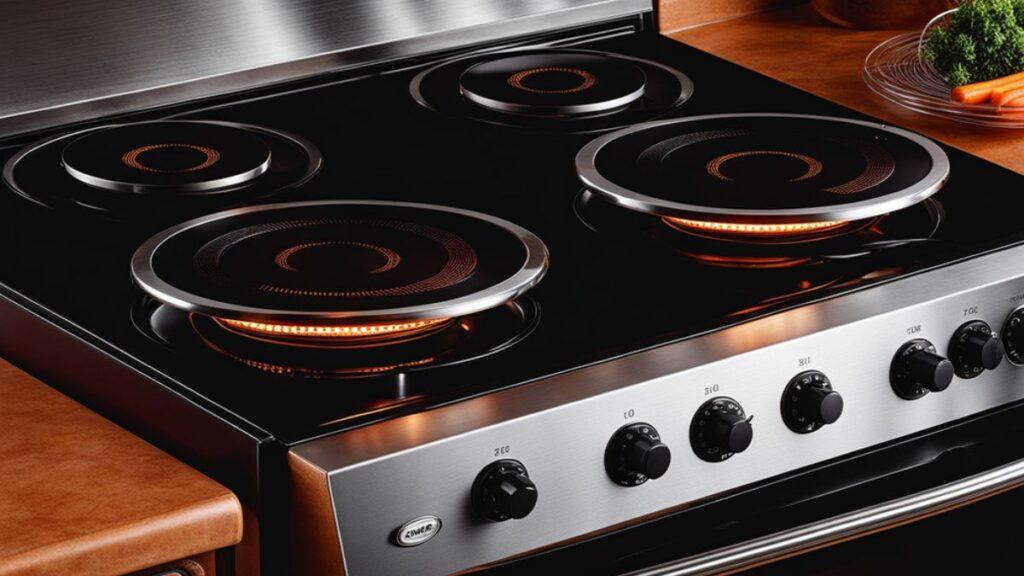
We may earn money or products from the companies mentioned in this post.
Electric stove elements typically range from around 100°F to 800°F (37°C to 427°C). They can vary depending on the setting and the stove’s design.
Electric stoves have become a staple in modern kitchens, offering a precise and efficient way to cook a variety of dishes. The ability to adjust the temperature of the stove element allows home cooks and professional chefs alike to simmer, boil, fry, or sauté ingredients with control.
Understanding the temperature range is essential for preparing meals perfectly and also for safety purposes. Reliable and easy to clean, electric stoves rely on these elements to provide consistent heat, making them an indispensable tool in culinary creation and everyday meal prep. With proper maintenance, electric stove elements can last several years, ensuring a warm welcome in any kitchen setting.
Read More: How Hot Does an Electric Stove Burner Get: Sizzling Facts!

Credit: www.amazon.com
Introduction
Exploring the nuances of electric stove element temperature is crucial for culinary precision. Understanding the specific heat settings can transform your cooking from good to gourmet, ensuring dishes are perfectly prepared every time.
Unlocking The Mysteries Of Your Electric Stove’s Heat, Understanding Electric Stove Elements

Every modern kitchen boasts an electric stove, but not everyone understands how they work. Essentially, the elements in these stoves convert electrical energy into heat, which is then used to cook your food. Knowing the nuts and bolts of these elements can dramatically improve your cooking results and safety.
The Science Behind The Heat
- Element Composition: Made from resistive wires that produce heat when an electric current passes through.
- Heat Transfer: The generated heat is directly transferred to your pots and pans for an efficient cooking process.
- Control Settings: Varying the electric flow, stove elements offer various temperature settings, typically marked from low to high.
Optimal Temperatures For Different Cooking Methods
It’s pivotal to understand that different recipes require different heat levels. For sautéing garlic, a medium temperature prevents burning, while searing a steak demands a high setting for that perfect crust.
Ensuring Even Cooking
- Pan Choice: Utilize flat-bottomed pans that make full contact with the element for uniform heating.
- Element Size: Match pan size to the element size. Mismatched sizes result in heat loss and uneven cooking.
- Regular Maintenance: Keep elements clean and free from food debris to maintain proper function and temperature control.
Dive into the world of electric stove cooking with newfound knowledge and explore the culinary delights you can whip up with precision and confidence. Whether you’re a beginner or an experienced home chef, mastering your electric stove’s temperature settings is the secret ingredient to delicious creations.
Read More: How Hot Does an Electric Stove Get: Sizzling Facts!
Mechanical Components

Understanding the thermal performance of electric stove elements is crucial for efficient cooking. Mechanical components like these elements reach varied temperatures to suit diverse culinary needs.
Understanding Electric Stove Elements
Electric stove elements are the workhorses of your kitchen appliance, converting electrical energy into heat for all your cooking needs. They are composed of several key mechanical components that work together seamlessly to provide consistent temperatures and controlled heating.
Key Of Stove Elements
The mechanical parts of an electric stove element might seem straightforward, but they are a symphony of design and engineering:
- Resistance Coils: The primary heating element in an electric stove, usually made of nichrome. These coils convert electric current into heat, glowing red when at high temperatures.
- Insulation Material: Positioned around the resistance coils, it’s required to prevent heat from transferring to unwanted areas and to protect the coils.
- Frame and Support: A robust structure, typically made of metal, holds all the components in place and ensures the durability of the element.
Function Of Temperature Controls
Temperature controls play a critical role in an electric stove. These are the brains of the operation, allowing you to adjust the heat output of the elements to suit your cooking needs.
Importance Of Regular Maintenance
Regular upkeep of your electric stove’s elements ensures peak performance and longevity:
- Cleaning: Remove any food debris or spills, as these can cause uneven heating and potential damage.
- Inspections: Look out for any signs of wear or damage on the coils and replace them if necessary, to avoid potential hazards.
Innovations In Stove Element Technology
We’re witnessing remarkable advancements in electric stove technology aimed at enhancing efficiency and safety while also cutting down on energy consumption. These modern elements heat up faster and cool down quicker, offering a safer cooking environment and energy savings.
Read More: How Hot Can an Electric Stove Get: Sizzling Facts!
Electrical Components

Understanding the electric stove element temperature is crucial for efficient cooking. It directly influences both the heating speed and the overall energy consumption. Properly managing the temperature settings enhances meal preparation and saves on electricity bills.
Understanding how your electric stove works is crucial when preparing your favorite dishes. Knowing the elements involved can help you better control temperature and ensure even cooking. Now, let’s dive into the electrical components that make your electric stove a key player in the kitchen.
The Heating Element
Electric stoves operate using heating elements that convert electrical energy into heat. But what exactly goes into these critical components? Let’s break it down:
- Material Composition: Typically, these elements are made of a high-resistance metal such as nichrome, a blend of nickel and chrome.
- Resistive Heating: As electricity passes through the resistive material, it encounters resistance, which generates heat.
- Spiral Design: The coiled design maximizes the surface area that comes into contact with the pot or pan, enhancing heat transfer efficiency.
Temperature Control Mechanism
Controlling the temperature of your electric stove’s elements is pivotal for culinary success. Here’s how the mechanism functions:
An electric stove’s temperature is regulated by a thermostat or an electronic control system, which adjusts the electrical flow to the heating elements. When you set a desired temperature on the knob or touchpad, the control mechanism:
- Senses the Temperature: It monitors the actual temperature of the stove element.
- Cycles On and Off: To maintain the set temperature, it will cycle the element’s power on and off.
Implementing this control ensures your dishes are cooked at the optimal heat level.
Electrical Circuitry
The circuitry in an electric stove is essentially the highway for electricity to reach the elements. Here’s a glimpse of the workings:
- Power Source: The stove is typically connected to a 220-volt power outlet to supply the large amounts of energy required.
- Wiring Configuration: Special high-temperature insulation protects the wires, ensuring safety and longevity.
- Circuit Protection: Safety devices like fuses or circuit breakers are installed to prevent electrical overload and potential hazards.
Safety Features
Safety is paramount when it comes to appliances that deal with high heat and electricity. Some of the built-in safety features in electric stoves include:
- Auto Shut-off: This feature turns off the element if it reaches an unsafe temperature or if a pot or pan is not present.
- Indicator Lights: These alert you when an element is turned on or still hot after being switched off.
- Ground Fault Circuit Interrupter (GFCI): This device can prevent electric shock by cutting off power if a ground fault is detected.
Engage with these insights the next time you’re whipping up a storm in the kitchen, and you’ll find yourself not just cooking, but also understanding the science that heats your delicious creations.
Read More: How Hot Can an Electric Stove Burner Coil Get: Sizzling Facts!
Temperature Range

An electric stove element offers a diverse temperature range, ideal for various cooking techniques. From simmering sauces to searing meats, these elements provide precise heat control for culinary perfection.
Understanding Electric Stove Element Temperatures
Have you ever wondered what’s the perfect heat setting for searing a steak or simmering a delicate sauce? Mastery of your electric stove’s temperature range is the key to becoming proficient in the kitchen. Electric stove elements can vary significantly in temperature, depending on their intended use and settings.
Having a good grasp of this can make the difference between a perfectly cooked meal and a culinary disaster.
:
A crucial piece of information for any aspiring chef is the temperature range their electric stove element can achieve. Across different models, the temperature varies:
- Low heat setting:
- Ideal for warming or simmering: This is where you keep food warm without further cooking, or gently simmer sauces and stews without boiling.
- Medium heat setting:
- The go-to for cooking: It provides a balanced heat that’s neither too aggressive nor too mild, making it perfect for sautéing vegetables or cooking a sunny-side-up egg.
- High heat setting:
- When searing and boiling is needed: High heat is used for getting a good sear on meat, boiling water quickly, or stir-frying, which needs rapid cooking at high temperatures.
Specific Common Temperatures And Their Uses
For dishes that require precision, knowing the specific temperatures of the element can elevate your cooking from amateur to professional. Here, we’ll explore certain temperatures and their culinary applications:
- 212°F:
- The boiling point of water: Perfect for boiling pasta, potatoes, and other ingredients.
- 300°F to 400°F:
- Ideal for baking and roasting: The oven typically uses these temperatures for evenly cooked pastries and well-roasted meats.
- Above 400°F:
- Necessary for searing: Getting that golden-brown crust on a steak requires temperatures that exceed 400°F.
Adjusting Stove Element Temperature
Achieving the desired temperature isn’t mere guesswork; it involves precision and understanding of your stove’s dial. To calibrate the right heat:
- Begin cooking at medium and adjust accordingly: Starting at a mid-range allows you to gauge the heat level and tweak it up or down.
- Recognize the signs of temperature change:
- Food behavior as a guide: Bubbles in a simmering pot that pick up the pace indicate a rise in heat, while a slowing sizzle typically points to a temperature drop.
- Always preheat the pan:
- Best practice for consistent cooking: Just as you preheat an oven, heating the pan before adding food ensures an even temperature throughout the cooking process.
Safety Precautions With High Temps
While embracing the heat can lead to delicious results, doing so safely is paramount. Here’s what to keep in mind:
- Handle with care:
- Protective gear is a must: Use oven mitts or pot holders when touching hot elements or pots, and keep flammable materials away from the stove.
- Never leave cooking unattended:
- Stay vigilant to prevent accidents: Always keep an eye on your cooking, especially when using high temperatures, to avoid fires or burning your food.
By getting to know the temperature capabilities and applications of your electric stove element, your cooking skills will surely heat up. Keep practicing, stay safe, and you’ll be creating culinary masterpieces in no time.
Read More: Discover Electric Stove Safety: How Hot Does Electric Stove Get?
Frequently Asked Questions Of Electric Stove Element Temperature
What Temp Is 7 On Electric Stove?
What Temperature Is High On Stove Burner?
What Burner Setting Is 350 Degrees?
What Is The Temperature Range Of A Burner?
Conclusion
Navigating the nuances of electric stove element temperatures can truly elevate your culinary skills. With the right knowledge, you can expertly manage heat for perfect results. Remember that mastery lies in the balance of temperature, timing, and cookware. Embrace the precision an electric stove offers and happy cooking!






